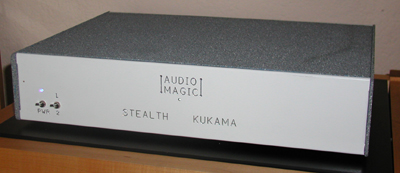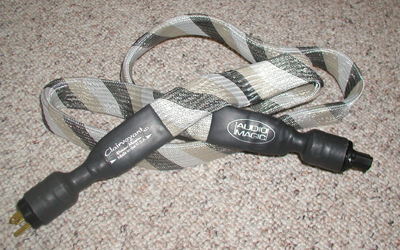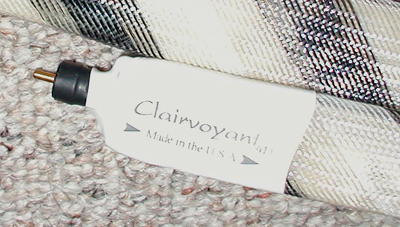|
You are reading the older HTML site
Positive Feedback ISSUE 7 audio magic Kukama DAC (review preview) as reviewed by Robert H. Levi
|
||
|
|
Audio Magic, a maker of AC filtering equipment and power cords, has introduced its first audio component: the Stealth Kukama DAC. Containing Burr Brown 1704 chips, an all-analog output stage, and powered by dual toroidal transformers, the unit offers automatic upsampling to 24/96 for all standard CDs. It will be sold direct by Audio Magic to keep the price to $2499. The unit features two toggle switches on its face, one for power and one to select between its two digital inputs. Lights on its face show power and digital lock. It has a detachable AC cord, two RCA digital inputs, and one pair of RCA outputs on the back. The test system consisted of a Sony SCD-1 used as a transport and connected via Kimber D-60 digital interconnect to the Kukama. The AC cable was a TARA Decade. The Kukama fed a Pass X-1 preamp via Kimber KCTG silver single-ended interconnects. The amps used were Pass 600 monoblocks driving a pair of Avalon Eidolons. A REL Stadium 3 Sub with its crossover set at 26 Hz provided deep bass. The Kukama was compared to two digital setups: a Theta Gen.5a/Jade combo connected with a Sam Papadas Custom Digital interconnect feeding the preamp with Kimber Silver Select Balanced Cable and the Sony SCD-1 in CD output mode feeding the preamp with Kimber Silver Select balanced cable. Neither upsample. All digital components were isolated with a Tice Power Block. Unfair, you say—the first setup costs over $8000 and the second $5000. How can a $2500 DAC compete? This is where the fun started. First up was a Wilson Audiophile CD, Brahms' Sonata No. 1 for Piano and Violin (WCD-8722), spun on the Theta setup. Rich sounds emerged, as the piano rang between the speakers and the oh-so-sweet rosin-tuned violin emerged left of center. This was definitely a 10 on a 10 scale of sonic realism. I then played the same CD on the Sony, yielding a different presentation. The piano was a bit thinner and more bell-like, but still rich and musical. The soundstage was a bit smaller, too—I'd say an 8 on a scale of 10. Then the Sony was switched to digital out and the Kukama sprang to life. I had been running it for 36 hours straight on break-in tones, so it was ready to sing. How did it sound? Very close to setup 2, I'd say a 7.5 on the sonic scale. The Kukama and the piano were quite simpatico, with the DAC fleshing out the chords and giving an accurate and textured performance. I would have preferred more warmth and a less detached, cool presentation, but this is a matter of taste. The sound was airy and compelling, never glassy or dry. The violin, a Guarnerius, was less warm and sweet than on the other references, but its presentation had emotion and excellent imaging. In fact, I'd put imaging at the top of the list of qualities the Kukama delivered. The upsampling appeared to enhance spatial presentation and you-are-there imaging. This was fun. On a hunch, I grabbed the Reference Recording, Mozart's Piano Concerto No.21 (RR-68CD), with Istomin at the piano. This is an HDCD recording, so it is loaded with oversampling info. The Theta has HDCD decoding, and again, of course, sounded like a 10—gorgeous. The Sony, which lacks HDCD decoding, was competent and musical—say a 7. The Kukama, with its upsampling but no HDCD chip, was excellent. It bested the Sony and bore in on the Theta sound—an 8. The piano floated in space between the Eidolons, and was both musical and accurate. The orchestra was layered and textured, never dry or thin. The sound was delicate, but not as delicate as the Theta's, textured, but not as textured as the Theta's. Though it appears that there is no substitute for HDCD decoding, it depends on the DAC at the end of the day. I've heard many HDCD DACs I would not own. HDCD discs maximize the sound of the Kukama, as the upsampling benefits are clearer and more attractive. At $2500, it's 80% as good as the Theta at $6050. To double-check my findings, I tried Reference Recordings' Rutter Requiem. On the first cut, "Praise Ye the Lord," the Kukama performed well. It had lots of depth and focus and a first-rate presentation of the choir, orchestra, and organ. The bass on the HDCD recording was tight, tuneful, and exciting. The Sony's sound was almost too close to call, though it was a bit less detailed and textured, and lost out to the Kukama overall. The seventh cut, "Pie Jesu," featuring soprano solo, was less textured on the Sony. Again, the Kukama was at its best with HDCD discs. I then went back to 16/44 CDs for a three-way shootout with the Brahms Violin Concerto with Hillary Hahn on Sony Classical (SK 89649). The Kukama sounded smooth and lively, but slightly thinner than I'm used to. The violin was focused and layered, but less sweet than usual. The overall sound was slightly smaller in width, but with excellent depth. The Sony SCD-1 was lively and enjoyable, with a big soundstage. The violin was sweeter, clearer, and more focused. The Theta rig demonstrated more drive and emotion. Orchestral colors were more easily apparent than with the other two DACs, and the soundstage was larger and deeper. The Kukama was edged out by the more expensive DACs, but it was tuneful and enjoyable. The plot thickened when I was FedEx-ed the Stealth digital cable and power cord with which the Kukama was voiced. The manufacturer says that these will be supplied as accessories at extra cost, for customers desiring to maximize the DAC's performance. I removed the Tara AC cord and Kimber D-60 digital cable and installed the Stealth cables, then revisited the Wilson piano and violin disc, switching back and forth between the Sony SCD-1 as a CD player and as a transport with the Kukama. The Kukama sounded richer, airier, and bigger than before, and in fact was now the equal of the Sony. Focusing first on the piano, then the violin, then the ambience, then the soundstage, then the decay of the instruments, I heard no difference between the two setups. It was time for a tiebreaker, so I put on Telarc's Choral Masterpieces (80119), with the Atlanta orchestra and chorus. Focusing on ambience, decay, soprano delicacy, and bass tightness, the Sony and Kukama sounded identical in all respects. Both had lots of air and sweetness and beautiful textures. Neither was quite in the league of the Theta, but terrific in their own right.
So, here we have a $2500 DAC (not counting ancillaries) that sounds like a $5000 Sony SACD/CD player, and better on HDCD disks. The Kukama does everything musically right. For $4000 more, it can be beaten as a DAC, but so what? At $2500, the competition is intense, but I know of no other DAC that will beat it in all parameters, though you have to buy the two Stealth cables. If you have a favorite CD transport but an older, obsolete DAC, here is your chance to upgrade at reasonable cost to near-current high end standards. If the Kukama is Audio Magic's first effort at developing audiophile gear, I can't wait to see what they do next. Robert H. Levi
|
|
|
|
Kukama DAC Audio
Magic
|



